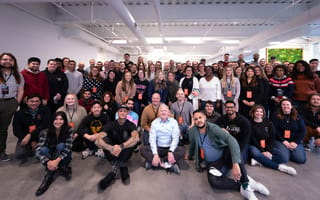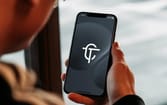What do you get when you combine a workforce that is half engineers with an ethos of love?
If you ask the team at Circulo, the answer is “an ecosystem of connection.”
Circulo is far from a traditional Medicaid insurance company. In fact, the team wants to rebuild this health insurance program from the ground up. The company provides tech-enabled care to underserved populations by connecting the huge amounts of disparate data that have been sitting unused at the center of healthcare for years. And while Circulo is still in nascent stages after its founding in 2021, CEO Sean Lane has a solid foundation. He’s been leading Olive, an AI healthtech unicorn, for nearly a decade.

Circulo integrates with Olive to facilitate optimized care in a monolithic industry, while also folding several proprietary tools into its Medicaid plan, such as a mobile telehealth van called the Circulator. It also delivers “whispers” to providers, which consolidate disparate, siloed data into tangible health management plans. The company even goes beyond medicine to address social determinants of health such as food and housing access.
To achieve its ambitious goals, the company has taken a unique approach in building a team composed of 50 percent engineers, with 57 of the 110 employees tackling technical work, and another ten focusing on design.
While engineering is classically left-brained work, Lane places heavy emphasis on the concept of love in daily operations. He asserts that this is the key to leadership, and even has a mnemonic to drive action.
The Meaning of Love, According to CEO Sean Lane
- L: Leadership. Everything is a leadership problem.
- O: Otherhood. Learn to consider others first and always.
- V: Vision. Discover the vision of others and help them achieve that vision.
- E: Expectations. All emotions come from expectations. Enumerate them clearly and often.
“It taps into the notion of servant leadership, as well as diversity and inclusion in how we approach our product and our teams,” said Head of Engineering Erika Bjune. “We bring vulnerability and psychological safety to the table so anyone can surface an idea and have it discussed respectfully. We hope to address problems with diverse and inclusive viewpoints while we build things.”
Autonomy is highly valued at Circulo. The distributed teams are able to work asynchronously, which frees the team up to do their best work fighting healthcare bureaucracy every day.
Built In talked to Bjune and two other members of the Circulo team to learn how the company is not only reinventing the wheel, but making it way more efficient.
Give me an overview of the industry. How does Circulo differentiate itself in a very competitive marketplace?
Software Engineer Nick Harder: Describing the healthcare industry would take a couple of days; it takes a long time to understand. One of our leads, Tom McMahon, has said, “If you’re new to the healthcare industry you might have the best ideas.” That indicates how much change needs to happen.
Senior UX Designer Eva Kang: We want to help people who need access to care, and we also want to help providers. Everyone who joins is enthusiastic about doing good and shifting the landscape for the better.
Head of Engineering Erika Bjune: There is a very deep human aspect to the work. There are so many women, children and older folks on Medicaid. There is a stigma about it, and we’re trying to bring dignity back to the people who rely on these systems.
Why is the workforce at the company half engineering?
Harder: We are focused on reducing the administrative burden in healthcare. These problems can be solved by engineers through automation. There are legacy processes in this industry that have a high administrative cost. Prior authorizations are a good example, where a provider needs approval from the health plan before they can take action. We are asking why we need that at all.
There are a lot of processes in healthcare that are inherently dehumanizing. We are not going to participate in those processes, so the solution is to have a team of 50 percent engineers coming up with new processes.
Bjune: People connect through technology and digital services, so it’s important for us to do this from an engineering standpoint. In the middle of everything in healthcare, there is a whole bunch of data that can help providers connect with and deliver medical services to members. This way, we can create an entire ecosystem of connection that currently doesn’t exist.
There are a lot of processes in healthcare that are inherently dehumanizing. We are not going to participate in those processes, so the solution is to have a team of 50 percent engineers.
What is notable about Circulo’s tech culture?
Kang: As a young company every piece of user feedback matters. That’s different than when you have hundreds of thousands of users and feedback is arbitrary. We take feedback seriously; it helps guide our next steps and improves the quality of what we are doing. Also, unlimited time off is pretty sweet!
Harder: What makes me feel valued is vulnerability. It is humbling. I reached out yesterday to someone who is building out the mobile app. I asked for a little information about authentication, and after sending me the information he said, “Let me know if we can improve this,” knowing I had taken a different approach in one of my projects. I felt immediately valued.
Bjune: From a technical standpoint, it is exciting to see the demos people bring to our team meetings every week. They are building technology based on the input of industry experts. We are still so early in our development, we are just starting the process of putting products in customers’ hands. It’s really exciting to get feedback from our first customers to see what is resonating.
It’s always great to have a retrospective culture. Every couple of weeks every team asks, “What went well? What didn’t go so well? What can we do better?” We’re helping each other improve all the time to build and deliver our technology. That culture is built into the DNA of our organization.
Since you are all new to this industry, has there been anything particularly surprising or that has stuck out to you through the learning process?
Kang: We can all relate to the experience of being a patient, but most of us have never been providers. Learning about the challenges on that side is interesting. For example, providers might be reluctant to accept Medicaid patients because of how they are treated by Medicaid insurance companies. We’re trying to fix that so providers and patients benefit.
Harder: On a call earlier this year, we talked to a provider and one of the top ten issues they had was the number of unpaid hours spent dealing with the health plan. For example, handling a denied claim with a 30-minute call, or figuring out why an authorization wasn’t approved on an hour-long call. It adds up to billions of dollars lost in the industry every year.
As an engineering-heavy organization, it’s surprising to find your CEO puts such heavy stock in “love.” Can you tell me how this materializes in the technical work you are doing each day?
Kang: When we thought about the mindset of people at all these touchpoints in the Medicaid system, there is a lot of love there for the people who are at the center of it. We also see that love in how we work with other team members. We try to move quickly and push boundaries, but we are realistic about working with other human beings during a pandemic. We try to be understanding with each other. There is a human aspect of this work, and we aren’t just pumping out products.
We try to move quickly and push boundaries, but we are realistic about working with other human beings during a pandemic.
Harder: One example of this is when I was working on infrastructure for a provider chat application through our mobile telehealth van, the Circulator, for the intellectually and developmentally disabled population. We were building functionality so that internal employees who control the van could coordinate with the providers. I found it difficult to focus on the intuitiveness of the design spec.
I was getting worried it might not get the effort it required. Two days later, on a different task, one of our engineers said he had completed that in addition to something else. He saw the need and thought, “This is something our providers deserve and we can do,” so he took action.
Tell me how DEI fits into your leadership plan.
Bjune: Diversity, equity and inclusion are hugely important to us. We are building for such a diverse audience and we need our staff to reflect that diversity as we build relevant products. We have put a lot of effort into ensuring diversity, equity and inclusion in our tooling internally and in the way we gather feedback from potential clients. On the engineering front, it is a challenge to build diverse teams. It’s one of the things I’ve wrestled with at every company, but I think Circulo has an intentional focus I haven’t seen in other organizations from the beginning.
Tell me about your products. What excites you the most about what you are building?
Harder: Our central hub of intelligence is called the knowledge graph, and it is one of the things I’m most excited about because a huge problem in healthcare is data siloing.
As a patient, when you go to a new provider you have to fill out the same information every time. Or if you go to a hospital, it’s difficult for your primary care provider to figure out what happened and get that data much later. If you go to specialists or change providers, you have to sign forms to send information to that provider. If you switch health plans, it’s hard to get information shared. The AI and technology we are building allow for a better understanding of our members.
This can be particularly impactful for issues such as social determinants of health. Having a knowledge graph should empower us to have a better understanding of our members in the long term.
Bjune: We have what we call whispers, which surface connections between data that have previously lived in separate systems. The spirit of a whisper is to correlate data to help providers.
Through Olive, our sister company, we can deliver loops, which are micro applications that offer specific functionality. Some loops might tap into data to help providers understand what other intersections the patient has had with the healthcare system in a way that’s compliant with health data privacy laws. Those bubble up as whispers.
We have loops that are specific to social services, for instance, recognizing that someone might require a special diet to manage a diagnosis but they don’t have great access to food. So we have food access information available. The same goes for housing. That information is put together in a unique way for the provider to use.
Someone might require a special diet to manage a diagnosis but they don’t have great access to food. So we have food access information available.
Your team utilizes asynchronous communication and flexible scheduling. How does this setup impact your work and work-life balance?
Kang: Personally, it’s been nice to be able to start my days touching base with team members. The second half of the day I get to be heads down, which gives me space to be creative. Because we have flexible schedules, it is nice for me to be able to start my day earlier and go for a hike at 4 p.m. There is a very strong sense of work-life balance.
Harder: As an engineer, a lot of the work can be done asynchronously. But the way we go about things here, I enjoy my work more.
I am a morning person 90 percent of the year, and then I’ll turn into a night person and wake up later. Obviously, there are meetings, but other than that it’s up to my interpretation of how I can get the work done that I need to get done, which comes down to setting expectations. I have never been able to so freely capitalize on asynchronous work, and have my best work and best life.
Our circle does a fantastic job of communicating openly in our Slack channel. There are countless times where someone runs into an issue and talks through it in Slack. If I run into the same problem I can search Slack and solve it in ten minutes, rather than spending half a day figuring it out.
Bjune: There is a higher quality of life that comes for me with asynchronous work, because I can make my own schedule, and using those hours is just different in an asynchronous organization. Decisions are made faster, you don’t have to wait for everyone’s calendars to align. You can have more impromptu conversations. It’s easier to share information in open public channels, which provides the benefits of inclusion and transparency. There are a lot of business benefits and work gets done faster.










